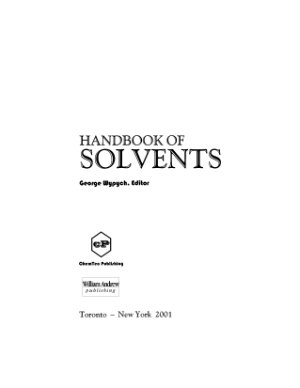Toronto - New York: ChemTec Publishing, William Andrew publishing,
2001. - 1694 p.
This book is intended to provide a better understanding of the principles involved in solvent selection and use. It strives to provide information that will help to identify the risks and benefits associated with specific solvents and classes of solvents. The book is intended to help the formulator select the ideal solvent, the safety coordinator to safeguard his or her coworkers, the legislator to impose appropriate and technically correct restrictions and the student to appreciate the amazing variety of properties, applications and risks associated with the more than one thousand solvents that are available today.
Fundamental principles goveing solvents use
Production methods, properties, and main applications
General principles goveing dissolution of materials in solvents
Solubility of selected systems and influence of solutes
Swelling
Solvent transport phenomena
Interactions in solvents and solutions
Mixed solvents
Acid-base interactions
Electronic and electrical effects of solvents
Other properties of solvents, solutions, and products obtained from solutions
Effect of solvent on chemical reactions and reactivity
Solvent use in various industries
Methods of solvent detection and testing
Residual solvents in products
Environmental impact of solvents
Concentration of solvents in various industrial environments
Regulations
Toxic effects of solvent exposure
Substitution of solvents by safer products and processes
Solvent recycling, removal, and degradation
Contamination cleanup: natural attenuation and advanced remediation technologies
Protection
New trends based on patent literature
This book is intended to provide a better understanding of the principles involved in solvent selection and use. It strives to provide information that will help to identify the risks and benefits associated with specific solvents and classes of solvents. The book is intended to help the formulator select the ideal solvent, the safety coordinator to safeguard his or her coworkers, the legislator to impose appropriate and technically correct restrictions and the student to appreciate the amazing variety of properties, applications and risks associated with the more than one thousand solvents that are available today.
Fundamental principles goveing solvents use
Production methods, properties, and main applications
General principles goveing dissolution of materials in solvents
Solubility of selected systems and influence of solutes
Swelling
Solvent transport phenomena
Interactions in solvents and solutions
Mixed solvents
Acid-base interactions
Electronic and electrical effects of solvents
Other properties of solvents, solutions, and products obtained from solutions
Effect of solvent on chemical reactions and reactivity
Solvent use in various industries
Methods of solvent detection and testing
Residual solvents in products
Environmental impact of solvents
Concentration of solvents in various industrial environments
Regulations
Toxic effects of solvent exposure
Substitution of solvents by safer products and processes
Solvent recycling, removal, and degradation
Contamination cleanup: natural attenuation and advanced remediation technologies
Protection
New trends based on patent literature

